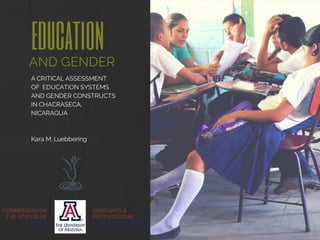Report
Share
Download to read offline

Recommended
Building economic, health and social capabilities adolescents threatened by H...

Building economic, health and social capabilities adolescents threatened by H...ABBA RPC (Addressing the Balance of Burden in HIV/AIDS)
Recommended
Building economic, health and social capabilities adolescents threatened by H...

Building economic, health and social capabilities adolescents threatened by H...ABBA RPC (Addressing the Balance of Burden in HIV/AIDS)
Presented at LILAC 2024.Information literacy and society: a systematic literature review - Dr Bruce Ryan

Information literacy and society: a systematic literature review - Dr Bruce RyanIL Group (CILIP Information Literacy Group)
Lessons from a decade's research on poverty alleviation4 Widening Paritcipation in Higher Education in Ghana and Tanzania, Fiona Leach

4 Widening Paritcipation in Higher Education in Ghana and Tanzania, Fiona LeachThe Impact Initiative
More Related Content
Similar to Luebbering-Workshop-Presentation
Presented at LILAC 2024.Information literacy and society: a systematic literature review - Dr Bruce Ryan

Information literacy and society: a systematic literature review - Dr Bruce RyanIL Group (CILIP Information Literacy Group)
Lessons from a decade's research on poverty alleviation4 Widening Paritcipation in Higher Education in Ghana and Tanzania, Fiona Leach

4 Widening Paritcipation in Higher Education in Ghana and Tanzania, Fiona LeachThe Impact Initiative
Similar to Luebbering-Workshop-Presentation (20)
Dr Margo Greenwood (March 2017) Community- Based Participatory Research: A S...

Dr Margo Greenwood (March 2017) Community- Based Participatory Research: A S...
9B16C002 SPARK SCHOOLS KINDLING INNOVATION IN SOU.docx

9B16C002 SPARK SCHOOLS KINDLING INNOVATION IN SOU.docx
Evaluation for Impact and Learning Asia Value Advisors Nov 6 2014

Evaluation for Impact and Learning Asia Value Advisors Nov 6 2014
Information literacy and society: a systematic literature review - Dr Bruce Ryan

Information literacy and society: a systematic literature review - Dr Bruce Ryan
Initiatives designed to support gifted and talented pupils in areas of socio-...

Initiatives designed to support gifted and talented pupils in areas of socio-...
EDU 505 – Contemporary Issues in EducationCOURSE DESCRIPTION.docx

EDU 505 – Contemporary Issues in EducationCOURSE DESCRIPTION.docx
4 Widening Paritcipation in Higher Education in Ghana and Tanzania, Fiona Leach

4 Widening Paritcipation in Higher Education in Ghana and Tanzania, Fiona Leach
Hepworth and Duvigneau- Is there a connection between building academics' res...

Hepworth and Duvigneau- Is there a connection between building academics' res...
Engaging Teachers in Student Surveys - White Paper for September 2015

Engaging Teachers in Student Surveys - White Paper for September 2015
A Social Problem Solving Intervention And Consultation Program

A Social Problem Solving Intervention And Consultation Program
Luebbering-Workshop-Presentation
- 1. COMMISSION ON THE STATUS OF WOMEN GRADUATE & PROFESSIONAL STUDENT COUNCIL
- 2. Objectives of the Assessment I. Undertake an assessment of the conditions, systems, risks, and opportunities related to educational access in Chacraseca in order to design appropriate and effective program strategies and interventions. II. Identify the root and underlying causes, and consequences, of school dropout rates and student absenteeism in Chacraseca. III. Determine the conditions that make adolescent females vulnerable to early termination of formal schooling. Kara M. Luebbering n January 30, 2015
- 3. Methodology I. A modified Rapid Assessment Process (RAP) study based on iterative data analysis, data collection, and triangulation. II. Coordinated with local leadership to collectively determine research plan and identify key insiders. III. Primary division in sampling done according to twelve geopolitical barrios. Within each barrio, determined a purposive sampling population from which a random sample was taken until data saturation reached. IV. Conducted 150 individual interviews, 6 focus group discussions, 6 key informant interviews. V. Performed 120 hours of classroom observation hours. Kara M. Luebbering n January 30, 2015
- 4. Kara M. Luebbering n January 30, 2015 Findings I. High enrollment rates, but 25% drop-out rate between the beginning and end of the year. Need metrics to evaluate effectiveness of formal education. II. Disconnect between schooling and learning. Need to increase the return on investment of education. III. Students drop-out because they cannot attend (illness, resources, etc.), will not attend (money for snacks, embarrassment, etc.), or do not attend (low return on investment, other priorities, etc.). IV. In general, women reach a diminished return on their educational investment earlier than men do in relation to employment opportunities.
- 5. Kara M. Luebbering n January 30, 2015 Implications of Findings I. School shifts from a center of learning to a space in which one explores relationships. II. Socialization of children outside homes occurs in classrooms where teachers often reinforce social norms about gender roles. III. In Chacraseca, rote education causes students to detach from information, the system does not allow students to develop critical consciousness in ways that encourage them to transform realities. IV. Once immediate needs are met, deeper structural issues manifest within education. Look to countries such as Nicaragua for insight into future trends in education after significant development support withdraws.
- 6. Kara M. Luebbering n January 30, 2015 Recommendations & Next Steps I. Engage students in their own development, invest in programs that allow youth to become agents of their own development. II. Alternative programs that enhance community-based education and educational initiatives for students that are relevant to their context. III. Recent follow-up with village leaders to determine various avenues for project design. Entering into the design and grant application process.
- 7. To request a copy of the full report, please contact the author at: kluebbering@email.arizona.edu Thank You!